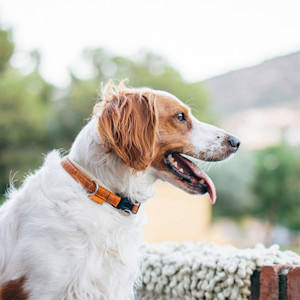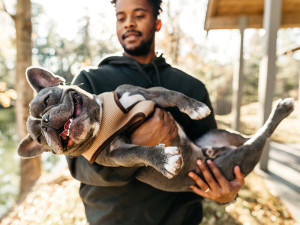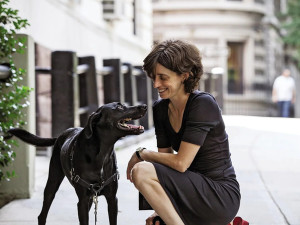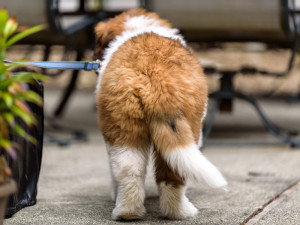Humans + Dogs: The Longest Love Story
How we became human — an ongoing exploration.

share article

Your pet wants you to read our newsletter. (Then give them a treat.)
Earlier this year, I lost my dog Remy. He was a true partner and a regal hound, perceptive and expressive; sometimes, it seemed that he knew what I was going to do before I did. During his last days, I often found myself holding my breath, hoping that by doing so, I might stop time as well, and keep death from coming for him.
Remy had been with me — loyal, attentive and engaged — for nine years. In many ways, this very personal and individual relationship was a manifestation of those bonds that humans have had with canines for thousands of years. Before horses, before cattle and swine, before goats or domesticated animals of any kind, dogs were by our side. While the exact point at which the wolf (Canis lupus)opens in a new tab became the dog (Canis lupus familiaris) is still up for debate, we do know that we have been running with canine companions for roughly the past 30,000 yearsopens in a new tab.
The history of dogs and humans
In the early days, the relationship was fragile, shaped by our separate and mutual needs, and by the harsh environment of the Late Pleistocene world — including the last ice age, when much of the planet was covered by glaciers. But by evolutionary chance, the unique bond that began so long ago has grown stronger through the eons and is now encoded within our very DNAopens in a new tab. Today, dogs understand us internally — studies showopens in a new tab hormonal and neural activity expressly reserved for human interaction and communication — and they keep us grounded externally, connected to the wild in ways large and small.
Outcompeting the Neanderthals Life was tough for humans when proto-dogs first came on the scene. Hominids (our early modern human ancestors) had been using toolsopens in a new tab for more than 2.5 million years, and fire for several hundred thousand. For our species, Homo sapiens, which emerged about 170,000 years before our future canine companions, progress was relatively slow. Between 90,000 to 70,000 years ago, widespread drought and unstable climate caused a significant reduction in the Homo sapiensopens in a new tab population, and remaining tribes had to compete with their Neanderthal contemporaries for resources.
One of science’s favorite adages is that correlation does not confirm causation. But it has not gone unnoticed by researchers that immediately following this time of struggle — between 50,000 to 33,000 years ago — a period of rapid human cultural development (including ritualistic burials, art and clothing) and advancement of complex hunting techniques coincided with the first traces of intentional human-canine interactions. In fact, some, including most notably anthropologist Pat Shipman, have argued that it is thanks to humans’ new wolf-dog companions that our species out competed, and ultimately survived, the Neanderthals.
It’s not hard to imagine that the coupling of human tools and weapons with canine speed and tracking capabilities created a formidable combination, one that benefited both partners. Indeed, at least one set of model studies with present-day hunter-gatherer tribes shows a more than 50 percent increase in hunting success when dogs are present. Dogs, in turn, are rewarded with steady meals and safe places to call home.
The first dogs
But even in those early days, something beyond mutual benefit seems to have connected our two species. Dogs, or rather, dogs’ ancestors, were the first animals to be domesticatedopens in a new tab. Notably, they are also the only large social carnivore and only canid that we’ve taken so thoroughly into our lives. While we can theorize, we still don’t know with certainty what drove the two species to give coexistence a go to begin with.
What we do know is that as early as 33,000 years ago, proto-dogs were being given ritual burials by their proud or grateful or perhaps even grief-stricken human companions. Photographs of the remainsopens in a new tab of a dog sent to the afterlife with a mammoth bone tucked deliberately (dare I say fondly?) in his mouth evoke wonder in me every time I look at them.
Ultimately, this relationship changed the course of human evolution in nearly every direction. Domesticating dogs paved the way for the establishment of more permanent settlements by making hunting easier and camp security better. Once we reached this point of stability, we began domesticating other animals. Finally, between 10,000 and 8,000 years ago, agrarian societies developedopens in a new tab, with predictable consequences for our diets, mobility (equine transportation!), and social relationships. Throughout this time, living with dogs enabled us to maintain links to the “natural order” away from which we were rapidly drifting.
All of this is to say that in essence, just as dogs are dogs because of us, we are humans because of them. Today, of all the domesticated animals we’ve surrounded ourselves with, we have the closest relationships with dogs. This may be partially because they have been able to adapt to the human social fabric more readily and ably than any other species. As a result, dogs are welcome and present both in the home and within the broader human environment, which they fluidly navigate.
The future of dogs
As is true of most developed countries, in the United States, we have largely shifted away from an agrarian society in which it was more common to see working and utility dogs rather than canine human companions. Today, Americans spend roughly $138 billionopens in a new tab on their (generally non-working) pets annually, and many report spending more on their dog or cat’s health care than on their own. Which raises the question: if, after 15,000 years, their primary place is no longer on the hunt or on the farm, what is dogs’ function in our modern, technology-driven human world — what role do they playopens in a new tab?
As someone who studies cognition, I’m heavily invested in science. But at the risk of sounding completely unscientific, I suggest that it’s something akin to “spirit guide,” creatures who both occupy our world and expand it.
The first time I worked from home without Remy, I closed my computer at the end of the day and was startled by what didn’t occur. Remy did not raise his head, stretch yawn and walk over to push his nose into my arm, silently urging Come on…it’s time to get out of here. Without his insistence, I had to think about what my next move was supposed to be. Noticing the time I spent outside. Just walking. Just being. Not looking at a screen. Ambling along the wooded trail without Remy beside me, I feel my body shrinking. For as much as Remy’s world was mine, he constantly enlarged it for me.
Amidst the noticing, I reflect on some of the things Remy taught me during our too-short time together, a feat surely only a dog could achieve.
How to deal with danger:
Aside from as hunting partners, dogs’ role as an alarm system was likely one of the main reasons early humans took so quickly to their presence. Today, dogs maintain their guardianship, alerting us to things we’ve forgotten how to pay attention to. With their protection, we are able to take risks, to be more confident navigating both human society and the natural world, which we know more about but of which we have far less physical experience.
How to come to our senses:
Early mammals relied heavily on their noses to gather informationopens in a new tab, and this was reflected in the structure of their brains. As species in the mammal class evolved and diverged, however, some (including primates, especially humans) became more reliant on other senses, such as sight. This, of course, came with a cost. Which explains in part why we forget that not everything we need to know about the world or our place in it can be seen.
How to get lost:
The first time I lost sight of Remy, I thought I would die. I thought he would die. He had just turned one and would be forever lost opens in a new tabto the mountain. But he wasn’t lost at all; he knew where I was and found me in due time, albeit far too long for my liking. While it was the first, it was certainly not the last time he took it upon himself to alter the course of an outing. As the years passed, I learned to let Remy “get lost,” and his gift was to let me do the same, to be alone but know that he would always find me. Even when we’re not in the wilderness, dogs invite us to abide momentary disorientation in service of experiencing a kind of peace, a solitude in the present, that our busy world rarely allows.
Clearly, dogs play many other important roles in the lives of modern humans, and they work hard at them. They enable the disabledopens in a new tab, detect diseaseopens in a new tab, aid in conservation, find bombs and drugs and lost people…the list goes on. So where do we go from here? How does this unique relationship continue to evolve, and what factors will influence how that happens?
Humans are social animals, as, of course, are dogs. Practically speaking, what this means is that humans require face-to-face interaction with others to learn, adapt and thrive. Though I can only cite anecdotal evidence in support, I have a hunch that as our virtual existence expands and we increasingly disconnect from one another and from the dwindling wild around us, dogs will remain our lifeline for real contact with the senses and the spaces we’ve abandoned.
Thirty thousand-odd years is a long commitment — one that in today’s world is especially hard to fathom. Yet, despite all the beeps and chimes vying for our attention, it seems to be one we humans are willing to honor. As for me, I would give anything to be lost in the moment, absently petting Remy’s velvet ears.

Courtney Sexton, MFA, MS
Courtney Sexton, a writer and researcher based in Washington, DC, studies human-animal interactions. She is also co-founder and director of The Inner Loop, a nonprofit organization for writers.
Related articles
![Alexandra Horowitz kneeling outside next to a happy black dog with a smile.]() opens in a new tab
opens in a new tabAlexandra Horowitz, The Canine Mindseeker
What do dogs know and how do they know it?
![Rhodesian Ridgeback dogs playing in summer grassy field]()
Understanding Canine Social Hierarchies
In case you’ve ever wondered what it’s like to live in a dog society.
![Back view of Saint Bernard puppy tail]() opens in a new tab
opens in a new tabIs Your Dog a Lefty or a Righty?
Your dog’s wag and paw preference say a lot about their personality.
![Man and golden retreiver laying on stomach looking at each other in bed]() opens in a new tab
opens in a new tabDog Whimpering: Why a Dog’s Whimper Affects Us
To pet parents, a whimpering dog sounds as sad as a crying baby. Here’s why.





